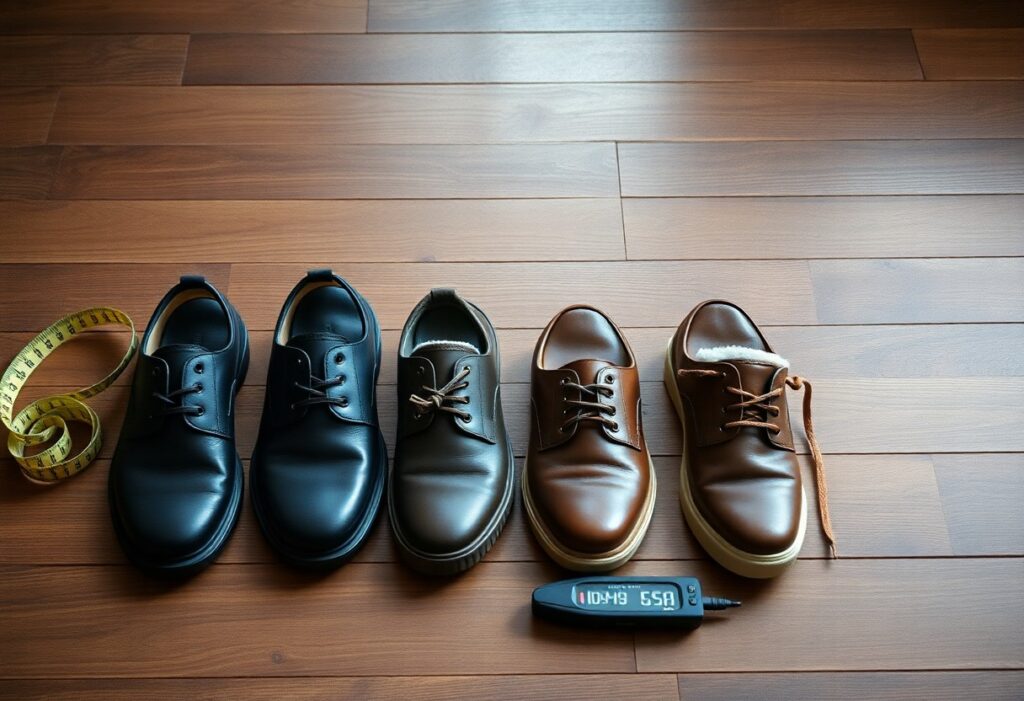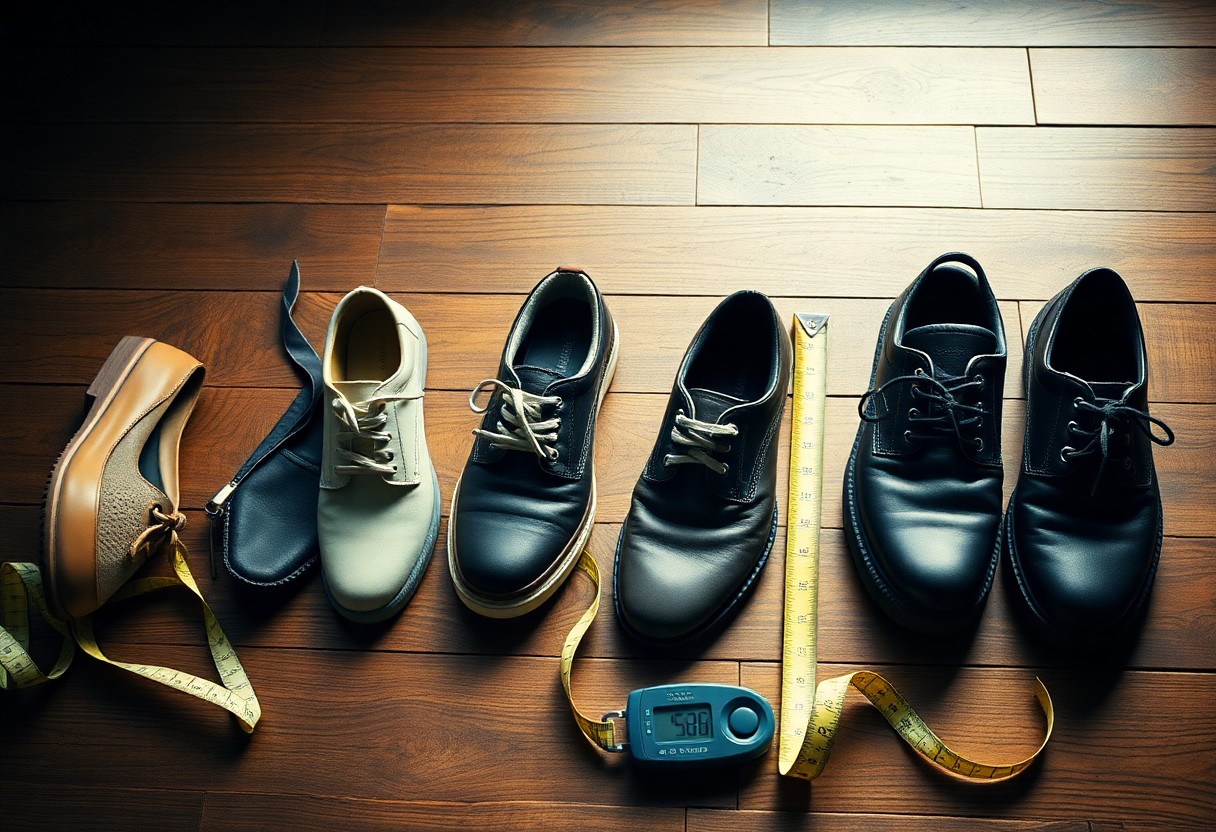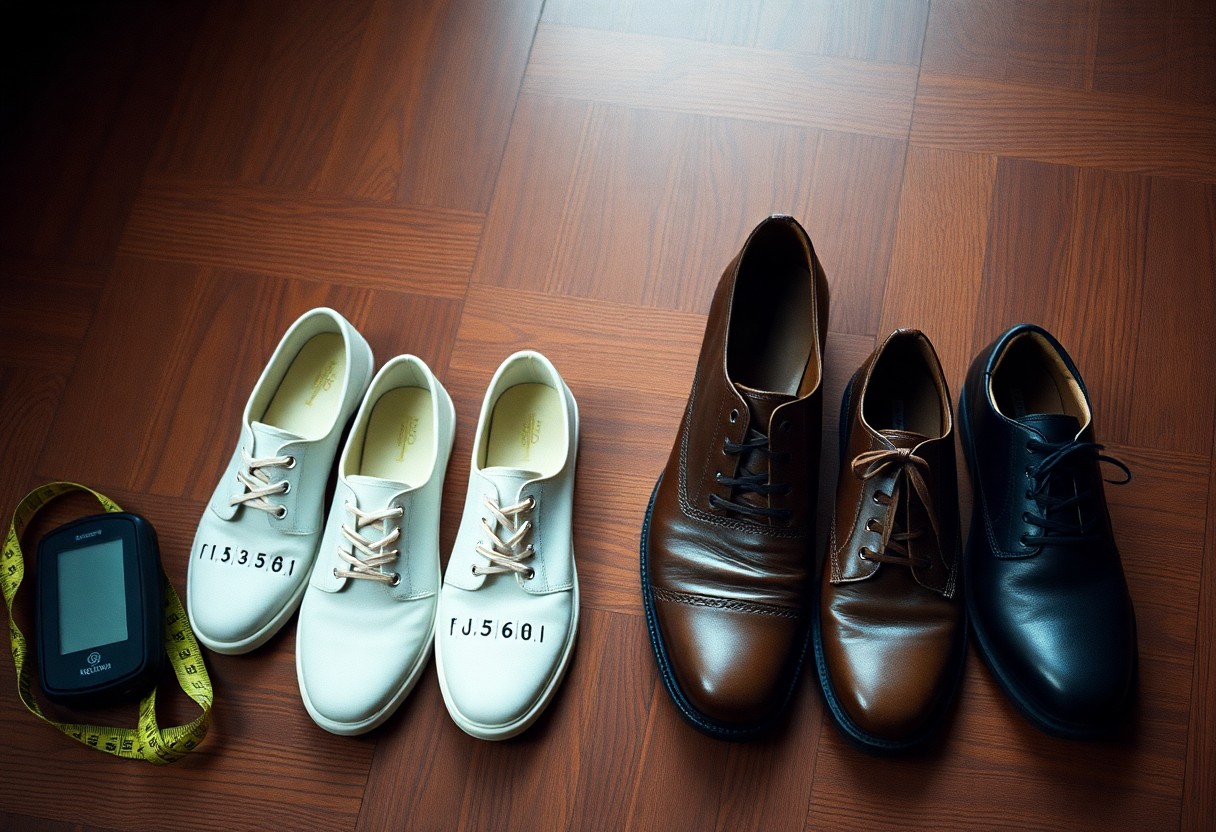Your cart is currently empty!
Shoe Width for Ultimate Comfort: Find Your Perfect Fit


Understanding the importance of selecting the right shoe width is vital for ensuring your overall foot health and comfort. Wearing shoes that fit well can greatly reduce foot pain and prevent various health issues. When you shop for footwear, it’s essential to evaluate both the length and width of the shoes to guarantee a snug fit. Choosing shoes with the correct width not only improves your stability and blood circulation but also lowers the risk of developing blisters and other foot-related ailments. To discover your perfect shoe width, measure the widest part of your foot and consult standardized width charts. Many individuals mistakenly prioritize length alone, overlooking the fact that adequate width is just as crucial for daily comfort and foot health.
Master the Art of Measuring Your Feet for the Perfect Shoe Fit
The most reliable way to determine your shoe width is to measure your feet at the end of the day when they are likely to have expanded slightly. Your foot width can vary by up to half an inch during the day, making evening measurements the most accurate. To do this effectively, stand on a sheet of paper and trace around your foot to capture the true outline. This straightforward technique can guide you in selecting shoes that not only fit well but also provide the necessary comfort and support your feet deserve throughout the day.
Effective Techniques for Accurate Foot Width Measurement
Alongside a standard ruler, consider using a Brannock Device, a specialized tool found in most shoe retailers that accurately measures foot size. This device specifically allows you to measure the widest part of your foot, typically located across the ball area. For the best results, ensure you measure both feet while standing, as it’s not uncommon for one foot to be slightly larger than the other. This approach will help you select shoes that comfortably fit the larger foot, minimizing the risk of discomfort during wear and enhancing your overall walking experience.
Avoid Common Pitfalls When Choosing Shoe Width
One of the most common mistakes made when selecting shoe width is overlooking the importance of accurate width measurements. Many people focus exclusively on length, which can result in discomfort and a range of potential foot problems. Additional frequent errors include measuring feet while seated and mistakenly believing that your foot width remains unchanged throughout your life. It’s crucial to understand that wearing shoes that are too narrow can lead to serious foot issues like bunions, corns, and hammertoes. Factors such as weight gain, pregnancy, and aging can alter foot size, so it’s advisable to measure your feet annually. Selecting the correct width can be a key factor in preventing blisters, calluses, and chronic foot pain.

Navigate Shoe Width Systems and Standards for the Best Fit
Understanding the different shoe width systems is crucial for ensuring optimal comfort and foot health. Various brands and countries utilize different measurement standards, so being familiar with these systems can help you select shoes that fit well and avoid foot-related problems. By knowing how width is categorized, you empower yourself to make informed decisions when selecting footwear tailored to your specific needs.
Decoding Letter-Based Width Scales for Better Shoe Fitting
When you’re shopping for shoes, widths are generally labeled from AA to EE. For women, a standard medium width is designated as B, while for men, it’s D. Narrow widths range from AA to B, and wide widths extend from D to EE. This letter-based classification helps you identify the right fit according to your foot shape, ensuring that your shoes offer the necessary comfort and support for your activities.
Understanding International Width Measurement Standards and Their Relevance
While shopping internationally, you may come across various measurement systems. For example, European sizes are based on millimeters, whereas UK sizes have their own width standards. Your US shoe size might differ from international sizes by one to two width sizes. Therefore, it’s essential to always consult the brand’s size chart for accurate international purchases. Japanese shoe sizes tend to run narrower, while European brands may feature a more generous toe box. To achieve the best fit, measuring your feet in millimeters is the most precise method for international sizing considerations.

Explore How Shoe Construction Impacts Fit and Comfort
To make informed choices about your footwear, it’s crucial to understand how shoe construction affects fit and comfort. The design and materials used in a shoe significantly influence how it fits and feels on your feet. Your overall comfort is closely linked to how the upper part of the shoe connects to the sole and the flexibility of the materials around the widest part of your foot. By selecting shoes with thoughtful and quality construction, you can enhance your comfort and ensure better support throughout your daily activities.
The Advantages of Using Natural Materials in Footwear
Shoes made from genuine leather offer exceptional breathability and flexibility. Leather has an inherent capacity to stretch and adapt to the contours of your foot over time, resulting in a customized fit. Studies show that leather shoes can expand by as much as 30% from their original width, making them a perfect choice for individuals with varying foot widths who prioritize comfort and adaptability in their footwear.
Durability and Uniformity of Synthetic Shoe Materials
Synthetic materials widely available in the market provide consistent width measurements and long-lasting durability. These modern fabrics protect your feet while offering advantages such as water resistance and enhanced breathability. Many synthetic shoes now incorporate mesh panels that promote airflow and flexibility. Furthermore, advancements in synthetic materials have led to the inclusion of comfort features like memory foam and gel inserts. Consequently, modern shoes can combine stable width measurements with targeted cushioning, delivering outstanding support during wear. Recent research indicates that synthetic materials can maintain their shape up to 40% longer than traditional materials, ensuring that your shoes hold their proper width throughout their lifespan.

Recognize Signs of Proper Shoe Width for Maximum Comfort
Unlike length, the correct shoe width can be assessed by how your feet feel and perform in the shoes. Your footwear should allow your toes to spread naturally as you walk, with about half an inch of space at the shoe’s widest part. Research reveals that 70% of people wear shoes that are improperly fitted in width, resulting in various foot complications. Being aware of the signs of proper width can enable you to make better footwear choices that promote comfort and health.
Essential Indicators of Comfort from Proper Shoe Width
Here are crucial signs that your shoes fit correctly regarding width: your toes should have the ability to wiggle freely, the ball of your foot should align with the shoe’s widest part, and you should not experience any pinching or pressure on the sides. A well-fitting shoe accommodates the natural expansion of your feet throughout the day, as feet can swell by up to 8% as the day progresses.
Red Flags Indicating Incorrect Shoe Width
During regular wear, it’s vital to be aware of warning signs such as numbness or tingling in your toes, blisters developing on the sides of your feet, and noticeable pressure marks on your skin after removing your shoes. These symptoms may indicate that your footwear is either too narrow or too wide. Maintaining the correct width is essential for your foot health, as studies show that ill-fitting shoes can lead to long-term foot problems. You should not feel any pressure points while standing or walking; if you notice pain, redness, or if your foot spills over the edges of the shoe, it may be time to explore different width options.
Comprehending Width Variations Across Different Shoe Brands
Numerous shoe manufacturers provide a range of width options, spanning from AA (super narrow) to 4E (extra wide). It’s important to understand that foot width can fluctuate throughout the day, and research indicates that up to 70% of individuals have differing widths between their left and right foot. Gaining insight into these variations will assist you in selecting shoes that accommodate your unique foot shape and help prevent discomfort and potential foot complications.
The Influence of Brand Differences on Shoe Width Measurements
When analyzing different brands, you may observe notable discrepancies in width measurements. A medium width in one brand might feel narrow in another. European brands often run narrower than American brands, while athletic footwear manufacturers typically provide the broadest width options. It’s always prudent to try on shoes prior to purchasing, as sizes can vary between manufacturers.
How the Style of Shoes Affects Width Fitting
The style of the shoe significantly influences how width fits your foot. Athletic shoes usually offer more flexibility in width compared to dress shoes, whereas sandals are crafted to accommodate a natural width. Your width requirements may vary based on the shoe’s intended purpose and the activities you plan to undertake. In-depth analysis shows that specific styles necessitate particular width considerations. For example, high heels require a firm fit to prevent slipping, while work boots might need additional width to comfortably fit thicker socks. Running shoes should ideally have about half an inch of space between your longest toe and the shoe’s front for maximum comfort and performance.
Identifying Unique Width Needs for Specific Foot Conditions
While standard sizing options are widely available, some individuals may require specialized width accommodations. If you face issues such as bunions, flat feet, or experience swelling, wider shoes may be necessary. Moreover, your foot width can fluctuate throughout the day, with studies indicating an increase in foot volume of around 4% by evening. Recognizing these changes is essential for selecting shoes that remain comfortable throughout your daily routines.
Foot Conditions That Necessitate Special Width Accommodations
Special width requirements often stem from various medical conditions. For individuals with diabetes, arthritis, or edema, it’s critical to have shoes designed with extra width for adequate circulation. Healthcare professionals may recommend specific width measurements to mitigate complications associated with these conditions. Research shows that 75% of individuals with foot conditions benefit from specialized width fittings, highlighting the significance of proper footwear in maintaining foot health.
Activity-Specific Width Requirements for Enhanced Performance
Leading an active lifestyle demands different shoe widths for various activities. For instance, your running shoes may require more width than your everyday footwear, while hiking boots need to allow space for thicker socks. Athletes often benefit from shoes that are half a size to a full size wider for high-impact activities, accommodating the necessary foot expansion during performance. In activity-specific fitting, consider your foot’s natural movement patterns. When running, your feet can expand up to half a size wider. For sports involving lateral movements, like tennis or basketball, adequate width is crucial to prevent foot strain and potential injuries. Your footwear choices should reflect your activity level and unique foot characteristics.
Discovering Your Ideal Shoe Width for Long-Lasting Comfort
The secret to finding your ideal shoe width lies in mastering proper measurement techniques and understanding the width options available. By measuring your feet at their widest point, recognizing your width category (which ranges from A to E), and selecting shoes that align with your measurements, you can ensure lasting comfort. Your shoes should fit snugly without pinching or sliding, allowing your toes the freedom they need to move naturally. By making informed choices about width and selecting materials suited to your feet, you can enjoy comfortable, well-fitting footwear that supports your daily activities.
Answers to Common Questions About Shoe Width
Q: What is the best way to measure my foot width at home?
A: To accurately measure your foot width, place your foot on a blank sheet of paper and trace its outline. Measure the widest part, usually located at the ball of your foot, using a ruler. It’s best to take this measurement in the afternoon when your feet are at their largest. Don’t forget to measure both feet, as one might be wider than the other. Use your measurements to compare against the shoe width charts provided by manufacturers.
Q: What are the standard width measurements for shoes?
A: Shoe widths typically utilize letter codes from A to E. For women, the standard medium width is B, while for men, it’s D. Narrow widths are represented by A and AA, while C and D indicate medium-wide for women. E and EE signify wide widths. Keep in mind that each brand may have slight variations in their width measurements, so it’s advisable to consult their specific size charts before making a purchase.
Q: How can I tell if my current shoes are the wrong width?
A: Look for the following signs: red marks on the sides of your feet, numbness in your toes, blisters on your heels or sides, and shoes that tend to slip off while walking. Your toes should have enough room to wiggle freely, and the ball of your foot should fit comfortably at the shoe’s widest part. If you experience pressure on the sides, it may be time to consider a wider shoe. Conversely, if your foot moves side-to-side in the shoe, you might need a narrower width.
The Article How to choose the right shoe width tips for a comfortable fit appeared first on My Shoes Finder
The Article Choosing the Right Shoe Width for Ultimate Comfort Was Found On https://limitsofstrategy.com
Comments
11 responses to “Shoe Width for Ultimate Comfort: Find Your Perfect Fit”
I can totally relate to this! A few years back, I started experiencing some serious foot pain, and it turned out I was wearing shoes that were way too narrow for my feet. Once I started paying attention to both width and length, it made such a difference in my daily comfort. I’d never really thought about that aspect before—going by brand sizing alone isn’t always reliable either.
It’s great to hear your experience! Finding the right fit can really transform how we feel day-to-day. So many of us tend to stick to familiar brands or styles, assuming they’ll work for us without really testing for comfort. I’ve had my own share of shoe mishaps, from shoes that looked sharp but felt like a torture device to ones that seemed comfortable at first but didn’t hold up during a long walk.
I’m glad to hear you found relief! If you’re looking for tips on how to choose the right shoes, check out this helpful guide.
https://forgottenportal.com/ninja
You know, I’ve always thought of shoe shopping as a sort of Olympic event. Length measurements? Check! Width? Uhh… *tosses a coin into the air.* Who needs that when I can just stare lovingly at the pretty shoes? But as you pointed out, there’s definitely a method to this madness, and I’ve learned that the hard way!
Your insights on the significance of selecting the right shoe width resonate deeply with many of us who have navigated the challenges of finding comfortable footwear. Having spent years working in a profession that demands long hours on my feet, I’ve come to appreciate the critical role that proper shoe fit plays in overall comfort and health.
I completely relate to your experience. The right shoe width can truly be a game-changer, especially for those of us who spend our days constantly on our feet. I remember when I first discovered how different widths could transform not just my comfort but also my overall energy levels throughout the day.
It’s wild how something as simple as shoe width can feel like a secret superpower, right? I used to think shoes were just supposed to look nice, but then I found the right fit, and it was like someone unplugged the weight of the world from my feet. Suddenly, I wasn’t just shuffling around like a zombie. I was gliding!
I can really relate to what you’re saying about the importance of finding the right shoe width. It’s surprising how something seemingly small can have such a massive impact on how we feel throughout the day. I’ve also spent long hours on my feet, and it wasn’t until I invested in properly fitting shoes that I began to notice a difference in my energy levels and overall well-being.
I can relate to that sentiment about finding comfortable footwear. It’s surprising how much impact the right shoe width can have, especially when you’re on your feet for long stretches. I remember when I first started working in a job with similar demands; I underestimated how much discomfort could affect my focus and energy levels throughout the day.
Your exploration of the nuances involved in selecting the appropriate shoe width raises several important points that resonate deeply with anyone who has experienced foot discomfort or pain due to improperly fitting shoes. In my own experience, I’ve learned firsthand how detrimental the wrong shoe size can be—not only in terms of physical discomfort but also how it can silently contribute to long-term health issues, such as joint pain and even posture problems.
It’s so true how deeply the right shoe size impacts not just immediate comfort but also our overall long-term health. I’ve definitely had my share of bad shoe choices, and it’s surprising how something as simple as width can affect everything from my daily activities to my mood.
Your insight into the importance of choosing the right shoe width resonates deeply with my own experiences. I used to overlook this aspect of shoe shopping entirely, focusing solely on the length and regrettably paying the price in discomfort. It wasn’t until I began to experience persistent foot pain that I decided to take a closer look at how my shoes were fitting me overall. I vividly remember purchasing what I thought was the perfect pair of sneakers, only to find that after a few hours of wear, they pinched my feet and left me with blisters.